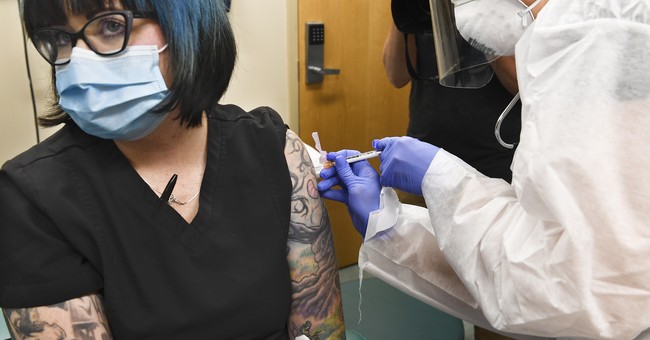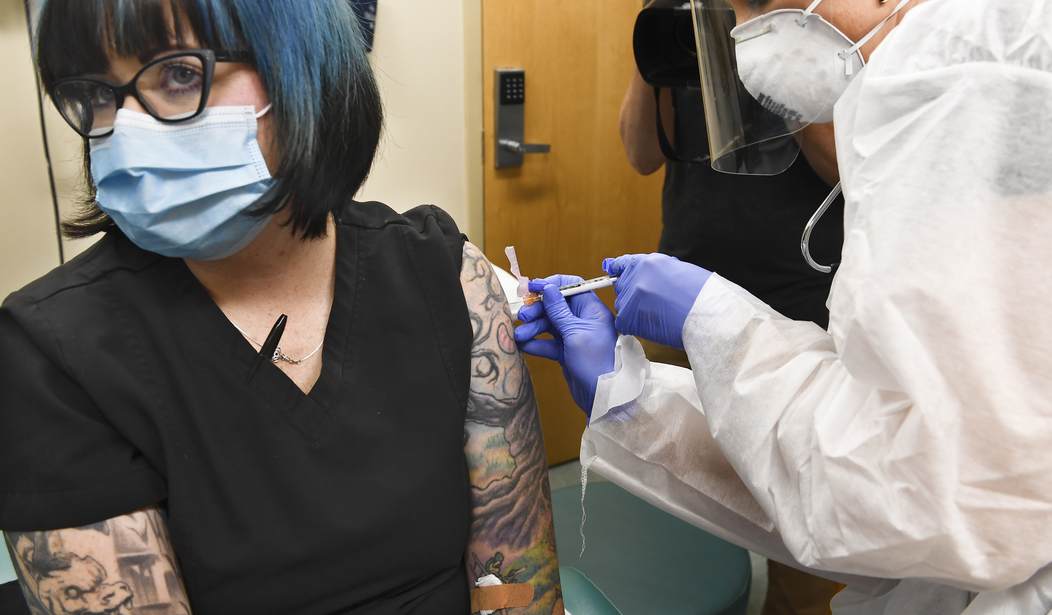
When the group of physicians called “Frontline Doctors” did their summit on COVID-19 last week, Google, Facebook, and Twitter banned the videos as soon as they started going viral.
Next, the group’s website got shut down by their hosting service, Squarespace.
As one of its members, Dr. Simone Gold, noted in what might be the most sensible remark ever committed to English:
Why are social media company employees with no medical degree or clinical experience censoring the perspectives of practicing physicians? Why are journalists claiming hydroxychloroquine is ineffective when there are numerous studies showcasing its efficacy against COVID-19?
Why are social media company employees with no medical degree or clinical experience censoring the perspectives of practicing physicians?
Why are journalists claiming hydroxychloroquine is ineffective when there are numerous studies showcasing its efficacy against COVID-19?
— Dr. Simone Gold (@drsimonegold) July 29, 2020
Dr. Gold’s employers, however, didn’t agree. She wound up losing her job for giving her professional opinion on a medical issue.
But the attempt by working physicians to educate the public on COVID-19 was smothered in more subtle ways as well.
As Dr. Gold’s remark indicates, to the extent her summit got any mainstream media coverage, the focus was entirely on a brief segment about the effectiveness of hydroxychloroquine. But, as Tucker Carlson pointed out while interviewing Dr. Gold, “It wasn’t an hour-long video on hydroxychloroquine.”
Indeed, it wasn’t.
That short segment on HCQ the media obsessed on was, in fact, just a very tiny part of a 7-hour event. But it makes sense that the corporate press would want to direct their attacks there. Not because it’s what most threatens their narrative, but because it’s the part of the conference that does so the least.
Most of the summit focused on two things:
(i) Pushing back against the relentless media gaslighting about COVID-19’s deadliness.
(ii) Shining a light on all the disastrous medical consequences of the unjustified state of panic we’ve been driven into and the horrors real doctors are dealing with every day as a result of the completely unnecessary and anti-science lockdowns it facilitated.
Focusing on the fact that “99.8 percent of people get through this with little to no progressive or significant disease” or child psychiatrist Dr. Mark McDonald’s unnerving presentation about the effects this relentless unjustified panic – which he called mass child abuse – is having on our nation’s children would have only drawn attention to the main point these frontline physicians were desperately trying to make the public understand:
It’s the panic, not the virus, that’s crushing the life out of America.
Focusing everyone’s attention on the tiny segment about the effectiveness of HCQ, on the other hand, perpetuates the hoax that we’re in dire need of some such remedy for a virus that, in reality, is less deadly than the flu.
Apart from the Democrats, no one stands to gain more from this hoax than the pharmaceutical-bureaucratic complex.
Big Pharma will rake in a fortune if the panic can be kept alive long enough for a vaccine to be approved.
Millions of Americans driven into a delusional unrelenting state of fear will line up to get the shot the second it’s available. And the state will likely force the rest of us to do so regardless of our wishes and even foot the bill.
But it turns out that the hoax is already putting billions of taxpayer dollars into Big Pharma’s coffers to help them develop and rush out a vaccine.
Much of the wasted money isn’t even staying in America.
As Breitbart just reported:
[T]he France-based pharmaceutical corporation Sanofi and GSK scored a $2.1 billion federal contract for 100 million doses of a vaccine with potentially the option to buy another 500 million doses. Sanofi profits total nearly $38 billion.
But don’t worry. American companies weren’t denied a seat on the gravy train.
Similarly, Pfizer and BioNTech won a $1.95 billion federal contract for an initial 100 million doses of their yet-to-be-developed vaccine for coronavirus. Pfizer is the largest multinational pharmaceutical corporation in the world with profits over $53 billion.
Other pharmaceutical corporations who have been awarded federal funds include:
Nearly $1 billion to Moderna
About $420 million to Johnson & Johnson
$1 billion to AstraZeneca
$1.6 billion to Novavax
$450 million to Regeneron Pharmaceutical
The American public has, of course, been convinced that only the speedy development of a vaccine can put an end to COVID-19’s scourge and return us to the days when it was safe to go outside not decked out like an extra from the Andromeda Strain.
Some Johns Hopkins professor moonlighting as a Big Pharma flack just published an op-ed in Forbes saying that we ought to start injecting people with experimental vaccines yet to be proven safe and effective right this minute.
His last couple of lines reminded me of the good old days when doctors used to appear in cigarette ads touting the many health benefits of smoking.
So let’s start vaccinating millions of people now, as soon as we can ramp up production. I’ll be first in line to try either the Moderna or the Oxford vaccine, as soon as it’s ready.
Doctors Agree!
Vaccines Are SAFE And Effective!The AMA (JAMA) was the tip of the spear in cigarette propaganda in the 1950’s raking in millions in ad dollars promoting cigarettes as health aids!
Why again, should we trust them on vaccines? https://t.co/Aop8hzVgGi pic.twitter.com/eVeHdy1jZn
— Shannon Joy (@ShannonJoyRadio) March 9, 2019
But the Washington Post just ran a story – perhaps laying the groundwork for the state’s ultimate refusal to give us back our most basic rights even after forcing a vaccine on us – that quotes a number of experts throwing cold water on the idea that a vaccine is going to do much to stop COVID-19.
In the public imagination, the arrival of a coronavirus vaccine looms large: It’s the neat Hollywood ending to the grim and agonizing uncertainty of everyday life in a pandemic.
I wonder where the public could have ever gotten that idea from?
But public health experts are discussing among themselves a new worry: that hopes for a vaccine may be soaring too high. The confident depiction by politicians and companies that a vaccine is imminent and inevitable may give people unrealistic beliefs…
“It seems, to me, unlikely that a vaccine is an off-switch or a reset button where we will go back to pre-pandemic times,” said Yonatan Grad, an assistant professor of infectious diseases and immunology at the Harvard University T.H. Chan School of Public Health.
Among the tidbits of information presented by Dr. Grad and other experts that put a damper on the rampant almost magical faith in a vaccine the press has instilled:
For those who do get a vaccine as soon as shots become available, protection won’t be immediate — it takes weeks for the immune system to call up full platoons of disease-fighting antibodies. And many vaccine technologies will require a second shot weeks after the first to raise immune defenses.
Immunity could be short-lived or partial, requiring repeated boosters that strain the vaccine supply or require people to keep social distancing and wearing masks even after they’ve received their shots.
Even the polio vaccine wasn’t the immediate panacea most of us think it was.
The Salk vaccination was a transformative moment, but it was also not the end of polio. Over the course of two years, cases in the United States dropped by 80%, but outbreaks continued for several years, even as the vaccine was rolled out. Six years later, an oral polio vaccine that could be given as a sugar cube that dissolved on children’s tongues was introduced.
Polio wasn’t eliminated in the U.S till 1979, a full 22 years after mass vaccination began.
The rush to distribute a polio vaccine also had some horrific consequences – or, as the Washington Post calls them, “bumps along the way.”
The “Cutter incident” became an infamous moment in medicine, when one of the suppliers of the [polio] vaccine failed to fully inactivate the virus in the shot, infecting about 40,000 children, paralyzing 51 and killing five. Those infections seeded their own epidemic, paralyzing 113 others and killing an additional five people.
Moreover, when government bureaucrats label some vaccine “effective,” the word turns out not to mean quite what the rest of us think.
All approved vaccines must be shown to be safe and effective, but that does not mean they perform the same. The measles vaccine is one of the best – 98% effective at preventing disease. But the flu vaccine clocks in most years at 40% to 60% effective. And some vaccines work less well in groups of people – older people, for example, have less robust immune responses and need a special high-dose flu vaccine, or one with an extra ingredient called an adjuvant. U.S. regulators will require a coronavirus vaccine to be 50% effective [my emphasis].
Let’s hope U.S. regulators don’t have a similarly eccentric understanding of “safe.”
Finally, the remarks of Michael Kinch, an expert in drug development and research at Washington University in St. Louis, about the four decade quest for an AIDs vaccine may be particularly illuminating.
The realistic scenario is probably going to be more like what we saw with HIV/AIDS. With HIV, we had a first generation of, looking back now, fairly mediocre drugs. I am afraid – and people don’t like to hear this, but I’m kind of constantly preaching it – we have to prepare ourselves for the idea we do not have a very good vaccine. My guess is the first generation of vaccines may be mediocre.
As I wrote way back in May in my expose’ covering the most important falsehoods propping up the COVID-1984 hoax:
Tens of billions of dollars and almost four decades have been spent trying to fulfill Fauci’s dream of finding an AIDS vaccine to no avail. And forget AIDS, we haven’t even been able to develop a vaccine for either of the other two strains of coronavirus that have proven dangerous; even though SARS-CoV has been around for 17 years and MERS-CoV for 8. Why on earth should we have any confidence that the prospects for finding a vaccine for baby brother COVID-19 are any better?
But even if they manage to come up with a vaccine that meets the stringent 50%-effectiveness threshold federal bureaucrats are insisting on, I wouldn’t throw out all your surgical masks just yet.
Insofar as the Washington Post is a bellwether of what the establishment has in store for us, needlessly wearing masks and the rest of the pointless COVID-1984 burdensome routine may turn out to be a permanent feature of American life.













